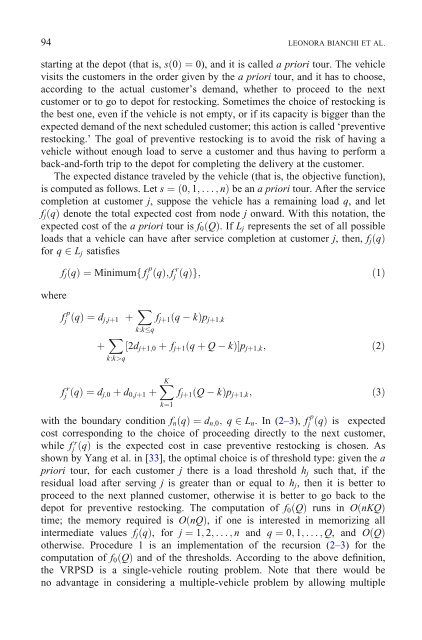Hybrid Metaheuristics for the Vehicle Routing Problem with ...
Hybrid Metaheuristics for the Vehicle Routing Problem with ...
Hybrid Metaheuristics for the Vehicle Routing Problem with ...
You also want an ePaper? Increase the reach of your titles
YUMPU automatically turns print PDFs into web optimized ePapers that Google loves.
94 LEONORA BIANCHI ET AL.<br />
starting at <strong>the</strong> depot (that is, sð0Þ ¼0), and it is called a priori tour. The vehicle<br />
visits <strong>the</strong> customers in <strong>the</strong> order given by <strong>the</strong> a priori tour, and it has to choose,<br />
according to <strong>the</strong> actual customer’s demand, whe<strong>the</strong>r to proceed to <strong>the</strong> next<br />
customer or to go to depot <strong>for</strong> restocking. Sometimes <strong>the</strong> choice of restocking is<br />
<strong>the</strong> best one, even if <strong>the</strong> vehicle is not empty, or if its capacity is bigger than <strong>the</strong><br />
expected demand of <strong>the</strong> next scheduled customer; this action is called Fpreventive<br />
restocking._ The goal of preventive restocking is to avoid <strong>the</strong> risk of having a<br />
vehicle <strong>with</strong>out enough load to serve a customer and thus having to per<strong>for</strong>m a<br />
back-and-<strong>for</strong>th trip to <strong>the</strong> depot <strong>for</strong> completing <strong>the</strong> delivery at <strong>the</strong> customer.<br />
The expected distance traveled by <strong>the</strong> vehicle (that is, <strong>the</strong> objective function),<br />
is computed as follows. Let s ¼ð0; 1; ...; nÞ be an a priori tour. After <strong>the</strong> service<br />
completion at customer j, suppose <strong>the</strong> vehicle has a remaining load q, and let<br />
fjðqÞ denote <strong>the</strong> total expected cost from node j onward. With this notation, <strong>the</strong><br />
expected cost of <strong>the</strong> a priori tour is f0ðQÞ. IfLj represents <strong>the</strong> set of all possible<br />
loads that a vehicle can have after service completion at customer j, <strong>the</strong>n, fjðqÞ<br />
<strong>for</strong> q 2 Lj satisfies<br />
where<br />
fjðqÞ ¼Minimumf f p<br />
j<br />
f p<br />
j ðqÞ ¼dj;jþ1 þ X<br />
k:k q<br />
r<br />
ðqÞ; f ðqÞg; ð1Þ<br />
j<br />
fjþ1ðq kÞpjþ1;k<br />
þ X<br />
½2djþ1;0 þ fjþ1ðq þ Q kÞŠpjþ1;k; ð2Þ<br />
k:k>q<br />
f r<br />
j ðqÞ ¼dj;0 þ d0;jþ1 þ XK<br />
k¼1<br />
fjþ1ðQ kÞpjþ1;k; ð3Þ<br />
<strong>with</strong> <strong>the</strong> boundary condition fnðqÞ ¼dn;0; q 2 Ln. In(2–3), f p<br />
j ðqÞ is expected<br />
cost corresponding to <strong>the</strong> choice of proceeding directly to <strong>the</strong> next customer,<br />
while f r<br />
j ðqÞ is <strong>the</strong> expected cost in case preventive restocking is chosen. As<br />
shown by Yang et al. in [33], <strong>the</strong> optimal choice is of threshold type: given <strong>the</strong> a<br />
priori tour, <strong>for</strong> each customer j <strong>the</strong>re is a load threshold hj such that, if <strong>the</strong><br />
residual load after serving j is greater than or equal to hj, <strong>the</strong>n it is better to<br />
proceed to <strong>the</strong> next planned customer, o<strong>the</strong>rwise it is better to go back to <strong>the</strong><br />
depot <strong>for</strong> preventive restocking. The computation of f0ðQÞ runs in OðnKQÞ<br />
time; <strong>the</strong> memory required is OðnQÞ, if one is interested in memorizing all<br />
intermediate values fjðqÞ, <strong>for</strong> j ¼ 1; 2; ...; n and q ¼ 0; 1; ...; Q, and OðQÞ<br />
o<strong>the</strong>rwise. Procedure 1 is an implementation of <strong>the</strong> recursion (2–3) <strong>for</strong> <strong>the</strong><br />
computation of f0ðQÞ and of <strong>the</strong> thresholds. According to <strong>the</strong> above definition,<br />
<strong>the</strong> VRPSD is a single-vehicle routing problem. Note that <strong>the</strong>re would be<br />
no advantage in considering a multiple-vehicle problem by allowing multiple
















